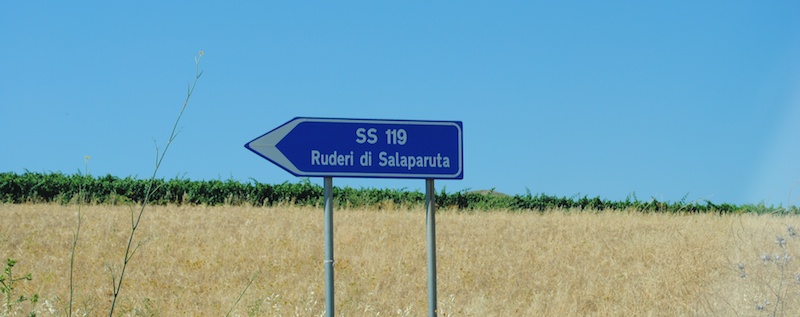 Some time between bedtime on January 14 and the morning of January 15, 1968, while Americans crowded around their black and white television sets watching Bart Starr and the Green Bay Packers dismantle the Oakland Raiders in just the second installation of a new, exciting professional [American] football championship that would come to be known as the “Super Bowl,” the inhabitants of the Belice Valley, a poor, rural area in southwestern Sicily were being jostled from their sleep by a magnitude 6.1 earthquake. That earthquake leveled a number of towns, among them Salaparuta, Poggioreale and Gibillina, claiming 380 lives, displacing over 70,000 people and shattering a rural lifestyle that tied these people to their land, their villages and their past, a way of life that was ingrained in villagers from their birth until their death.
Some time between bedtime on January 14 and the morning of January 15, 1968, while Americans crowded around their black and white television sets watching Bart Starr and the Green Bay Packers dismantle the Oakland Raiders in just the second installation of a new, exciting professional [American] football championship that would come to be known as the “Super Bowl,” the inhabitants of the Belice Valley, a poor, rural area in southwestern Sicily were being jostled from their sleep by a magnitude 6.1 earthquake. That earthquake leveled a number of towns, among them Salaparuta, Poggioreale and Gibillina, claiming 380 lives, displacing over 70,000 people and shattering a rural lifestyle that tied these people to their land, their villages and their past, a way of life that was ingrained in villagers from their birth until their death.
At that moment, my friend and college roommate Peter was but a lad of 8, probably watching this newfangled “Super Bowl” with his father, mother and brothers in their very American home in a Connecticut town. The terremoto di Belice – the Belice earthquake – could not have even registered with young Peter. Nearly a half century later, however, Pete, a descendant of a family that traces its routes back to Salaparuta, was able to experience firsthand the destruction that befell his paesani and to trace the famiglia back to his ancestral home. I was privileged enough to be able to observe and share that experience with him.
* * *

After a late morning visit to nearby fishing town of Sciacca and a fabulous lunch at one of its restaurants, we loaded up the cars and caravanned north into the Belice Valley, about 45 minutes inland. The drive included stretches along Sicily’s modern highway system, which twisted through deep, rocky valleys and along steep mountains, their peaks dotted with enormous modern windmills generating electricity for the valley’s populace. We exited the autostrada for a state road, again modern, well paved and smooth, but following the natural terrain where the highway invented roadway by erecting enormous bridges suspended hundreds if not thousands of feet above the valley floor. Along the way we passed what we thought might be our destination, Salaparuta, Pete’s ancestral home. False alarm. The modern town was Poggioreale, Salaparuta’s neighbor and, one would imagine, it’s bitter enemy in olden times.
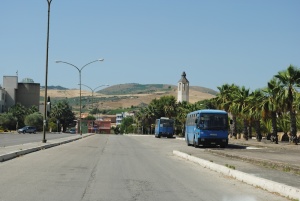 At last, the road made a sharp turn to the right and above us on a hill was Salaparuta. To say it was not what we (or at least I) had expected would be an understatement. As we approached the town along a road wide enough for 15 to 20 Italian sized cars, we were greeted by the typical cascading of buildings down the hillside, which is a hallmark of Italian urban design. But instead of the usual mass of houses perched one above the other, side by side in an explosion of disorderliness, the town that greeted us was expansive, orderly, clean and modern. It had the look of one of those California-style planned communities, straight from the opening scene of E.T. As clean and appealing as it was, it did not look like Italy.
At last, the road made a sharp turn to the right and above us on a hill was Salaparuta. To say it was not what we (or at least I) had expected would be an understatement. As we approached the town along a road wide enough for 15 to 20 Italian sized cars, we were greeted by the typical cascading of buildings down the hillside, which is a hallmark of Italian urban design. But instead of the usual mass of houses perched one above the other, side by side in an explosion of disorderliness, the town that greeted us was expansive, orderly, clean and modern. It had the look of one of those California-style planned communities, straight from the opening scene of E.T. As clean and appealing as it was, it did not look like Italy.
This is what happens when your village is destroyed in the middle of the night and has to be rebuilt. Where Salaparuta once sat, or, rather, as we were to later discover, a mile or so from the original village, was a Hollywood version of a town. Perfectly lovely in every respect. But plopped down where nothing had been before, itself having been nothing before but a mass of cement and wood moulded into a perfectly fine village by well intentioned bureaucrats and builders. But this was a case of the whole being much, much less than the sum of its parts. On a very first impression new Salaparuta was of a place without a soul, because it was a place without a past. And in Italy, the past is the trellis on which the ivy grows, is the canvass on which the present can be painted, is the mother from which the new vinegar is born.
* * *
I think that Pete was a bit shaken by his initial impression of new Salaparuta as well. Perhaps it was the fact that we arrived during siesta hour and there were just a few signs of life on the lonely streets. But regardless of the reason, we opted to look for the old Salaparuta, the remains of the town where Pete’s grandfather had been born, from which he emigrated in the 1890s. The town that, despite its poverty had made a name for itself as the home of several fine Italian wines, including Duca di Salaparuta and the Corvo winery. And so up the mountain we drove along a nearly abandoned track that was rutted with deep gullies and whose pavement was missing as much as it was extant. Unlike the drive from Sciacca to new Salaparuta along roads invested in and maintained by the government, this was an area that had been largely abandoned, mostly forgotten.
he emigrated in the 1890s. The town that, despite its poverty had made a name for itself as the home of several fine Italian wines, including Duca di Salaparuta and the Corvo winery. And so up the mountain we drove along a nearly abandoned track that was rutted with deep gullies and whose pavement was missing as much as it was extant. Unlike the drive from Sciacca to new Salaparuta along roads invested in and maintained by the government, this was an area that had been largely abandoned, mostly forgotten.
The road was punctuated here and there with signs for the ruins of Salaparuta but there was no sense when we would reach the town or what we would find. At last, however, we rounded a turn and viewed off to the right a distant town. And even in the distance we could see that none of the town’s buildings had any windows. It was a ghost town, still completely standing but obviously, even from this distance, uninhabited and abandoned. But as we neared the entrance to the town the road switched back to the left and the sign indicated that Salaparuta, the old Salaparuta, the ruins of the city destroyed in 1968 were to the left. What lay to the right was the remains of Poggioreale, the neighboring town to Salaparuta, also rendered uninhabitable in the ’68 earthquake but obviously not reduced to rubble, as we would find Salaparuta had been.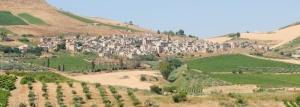
So up the goat track we continued until a large ruined building with only a central arch standing lay in our path. And to the right was the familiar sight of a local cemetery, the old  cemetery of Salaparuta. We parked our cars and walked toward the gate, which was pulled closed and sported a large padlock. Fortunately, however, the gate was not locked and we pushed it open and entered. It was the first time I had walked through an Italian cemetery, despite the fact that we have one located across the road from our villa in Umbria. I have passed them often and noted how they look like little towns, surrounded by a high wall and sporting a number of peaked roof buildings, each a mausoleum dedicated to a family, but looking from the outside like little houses. This one, the cemetery of Salaparuta, was clean, tidy, neatly laid out and well cared for. Italians seem to revere their past, their relatives and the memories of them. This was certainly the case in Salaparuta.
cemetery of Salaparuta. We parked our cars and walked toward the gate, which was pulled closed and sported a large padlock. Fortunately, however, the gate was not locked and we pushed it open and entered. It was the first time I had walked through an Italian cemetery, despite the fact that we have one located across the road from our villa in Umbria. I have passed them often and noted how they look like little towns, surrounded by a high wall and sporting a number of peaked roof buildings, each a mausoleum dedicated to a family, but looking from the outside like little houses. This one, the cemetery of Salaparuta, was clean, tidy, neatly laid out and well cared for. Italians seem to revere their past, their relatives and the memories of them. This was certainly the case in Salaparuta.
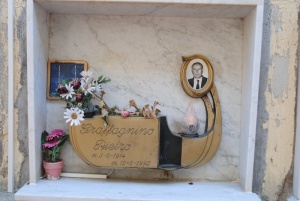 It took only a minute for us to come across the first Graffagnino buried there. Ironically, not just a Graffagnino but a Pietro Graffagnino. Then another and another. And within a few minutes more someone came across a Graffagnino
It took only a minute for us to come across the first Graffagnino buried there. Ironically, not just a Graffagnino but a Pietro Graffagnino. Then another and another. And within a few minutes more someone came across a Graffagnino  mausoleum, a tidy white marble building with four family members laid to rest and a small interior shrine on which there were fresh flowers and recently burned candles. We noted the names, the dates and the photos that were included. Pete attempted to clean the carved name at the top of entrance and which had been smudged with dirt and grime. He found a broom inside the crypt and wetted it down with water from a nearby faucet and attempted to scrub away the grime. All that resulted, however, was a spreading of the streaky dirt over the rest of the name. Nonetheless, his relatives would have been proud of his efforts to clear their name.
mausoleum, a tidy white marble building with four family members laid to rest and a small interior shrine on which there were fresh flowers and recently burned candles. We noted the names, the dates and the photos that were included. Pete attempted to clean the carved name at the top of entrance and which had been smudged with dirt and grime. He found a broom inside the crypt and wetted it down with water from a nearby faucet and attempted to scrub away the grime. All that resulted, however, was a spreading of the streaky dirt over the rest of the name. Nonetheless, his relatives would have been proud of his efforts to clear their name.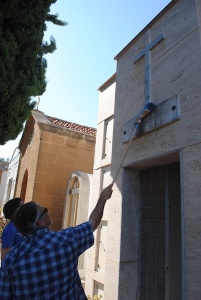
It was difficult to tear ourselves away from the cemetery. Of the eight who entered, only one had any connection to this place and to the people whose bones lay inside. Yet each of us, Pete, his wife, Suzy and I who have known Pete for many years and our four friends who had only met him days before, felt a connection with Pete and his journey. There was a shared reverence and a sense of shared purpose that was truly inspiring.
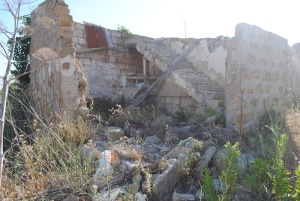 But after a while it was time to move on, to continue searching for the old Salaparuta, the ruins of the ancestral village. We pressed on and only a few hundred yards from the cemetery we came upon it, a few fragments of buildings jutting out of the underbrush. We stopped the cars and walked up and down a few minor roads that ran through the piles of rubble. They were obviously the old streets, roads that carried the citizens from house to house for generations but which fell
But after a while it was time to move on, to continue searching for the old Salaparuta, the ruins of the ancestral village. We pressed on and only a few hundred yards from the cemetery we came upon it, a few fragments of buildings jutting out of the underbrush. We stopped the cars and walked up and down a few minor roads that ran through the piles of rubble. They were obviously the old streets, roads that carried the citizens from house to house for generations but which fell 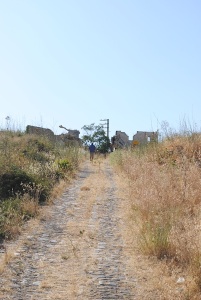 silent 45 years ago. It was a scene of silence, there was no traffic, no chatting and laughing, just the breeze softly blowing through the grass and weeds that were growing over these monuments to the several dozen citizens who perished in the earthquake and the to others whose lives would never be the same again.
silent 45 years ago. It was a scene of silence, there was no traffic, no chatting and laughing, just the breeze softly blowing through the grass and weeds that were growing over these monuments to the several dozen citizens who perished in the earthquake and the to others whose lives would never be the same again.
Among these old, weed covered streets there was no grand monument, no postcard memory of a great castle, majestic church or noble estate that could be pointed to as what Salaparuta was. There was, simply, nothing. Just a mountain hillside with a few road and some piles of rubble that used to be the Salaparuta of Pete’s grandfather’s time. And as we got back in our cars and headed back to Hollywood Salaparuta, leaving prehistoric rubble Salaparuta in our mirrors, it seemed so unfair, so sad, so random that a place could be here one day, its citizens engaging in the mundane affairs of tending to their fields, talking around their dinner tables about the trouble the little Russo boy had gotten into, paying respects to their relatives in the cemetery and the next moment having it all – everything they owned, cherished and knew – reduced to nothing. Loss is one thing. Complete loss is something else altogether. How does the spirit, so ephemeral and independent, survive without the anchor of place?
* * *
We returned to new Salaparuta as the population was beginning to emerge for the nightly passagiata in the main, new square. It was not hard to find, as there is only one main square in the town. Here we decided to get a coffee and some water for our thirst and speak to an adult to see if anyone know whether Pete’s relative, the town’s pastor from a generation ago, Father Baldassare Graffagnino, was still alive and if so, how we could contact him. We entered the bar, located just off the expansive cement piazza, which was overrun by ten year old boys who were playing video darts. We ordered some drinks and then started our conversation with the bartender, a young man of about 30. Acting as translator I told him that we were Americans (obvious) and that Pete’s family was from Salaparuta. Pete showed the bartender his passport and when he read “Graffagnino” he  became excited. The butcher, whose shop was just on the piazza was a Graffagnino. He confessed that he did not know Father Baldassare or whether the padre was still alive.
became excited. The butcher, whose shop was just on the piazza was a Graffagnino. He confessed that he did not know Father Baldassare or whether the padre was still alive.
We headed out across the square to see the butcher of Salaparuta, a Graffagnino from handle to blade. Unfortunately Wednesdays are his early closing day. The encounter with the butcher would have to wait until the next trip. Returning to our outdoor table we noticed a group of Salaparuta’s older citizens, a half dozen old men hanging out in a corner of the piazza. Surely they would know Baldassare and whether he was still alive.
 So we walked up to them, me a little hesitant playing the role of translator but eager to help out Pete. We approached them, introduced ourselves and launched into our script. We were from the U.S. Pete’s family emigrated from Salaparuta several generations ago. His name was Graffagnino and we were hoping to find his relative Father Baldassare Graffagnino if the father was still alive and in the area. The old men couldn’t be nicer, more interested or more helpful. Several of them spoke good English. All of them knew the Graffagnino name and they knew that Father Baldassare was alive and although in advanced age, doing well in the retirement home just a few blocks away from the piazza. In fact, the home accepted visitors and the Padre would probably be at dinner even now. Pete thanked the men and we headed for the car for our visit with Father Baldassare Graffagnino.
So we walked up to them, me a little hesitant playing the role of translator but eager to help out Pete. We approached them, introduced ourselves and launched into our script. We were from the U.S. Pete’s family emigrated from Salaparuta several generations ago. His name was Graffagnino and we were hoping to find his relative Father Baldassare Graffagnino if the father was still alive and in the area. The old men couldn’t be nicer, more interested or more helpful. Several of them spoke good English. All of them knew the Graffagnino name and they knew that Father Baldassare was alive and although in advanced age, doing well in the retirement home just a few blocks away from the piazza. In fact, the home accepted visitors and the Padre would probably be at dinner even now. Pete thanked the men and we headed for the car for our visit with Father Baldassare Graffagnino.
* * *
Salaparuta’s retirement home is just what you’d expect from a retirement home. Institutional architecture, staff in white uniforms and a few demented patients sitting in the waiting area talking to themselves. It is not the sort of place you come to for a laugh and a smile. Unless, that is, if you are visiting the brother of your great great great great grandfather (a sixth cousin or some other such distant relationship), one of the last of your 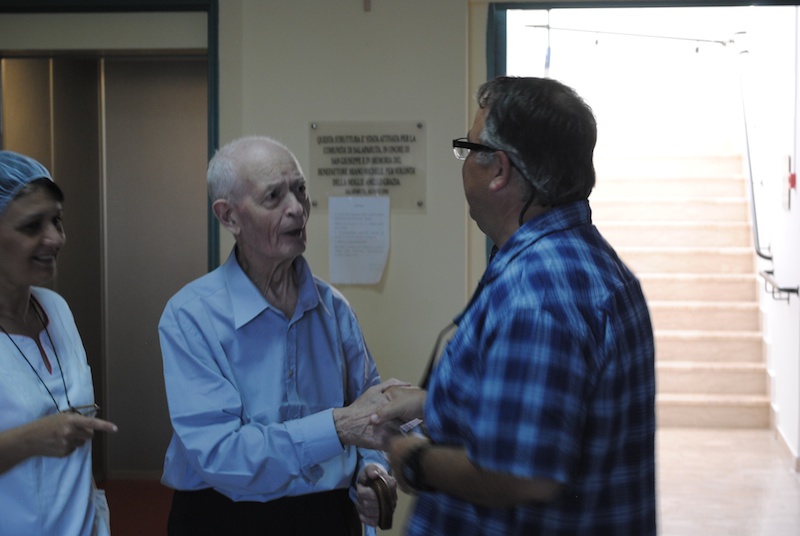 line in his ancestral home. After explaining to the nurse the purpose of our visit, she told us she would be right back with Father Baldassare and right she was. In less than a minute the elevator doors opened and out bounded a thin, white haired man with a twinkle in his eye and a cane in his hand. At eighty nine, Father Baldassare still had a strong life force in him, and, as the Graffagnino family historian, a passionate interest in keeping alive the family history. He was as interested in meeting Pete as Pete was in meeting him.
line in his ancestral home. After explaining to the nurse the purpose of our visit, she told us she would be right back with Father Baldassare and right she was. In less than a minute the elevator doors opened and out bounded a thin, white haired man with a twinkle in his eye and a cane in his hand. At eighty nine, Father Baldassare still had a strong life force in him, and, as the Graffagnino family historian, a passionate interest in keeping alive the family history. He was as interested in meeting Pete as Pete was in meeting him.
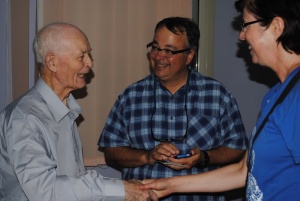 For the next hour Pete and Father Baldassare shared stories and asked questions of one another. And every so often the soft spoken Baldassare would look toward Pete (his eyesight is failing) and would lean over, and kiss him on the cheek. Then he would turn to Pete’s wife and do the same. He even offered me a peck. It – the peck and the experience of sharing this homecoming, the visit to the
For the next hour Pete and Father Baldassare shared stories and asked questions of one another. And every so often the soft spoken Baldassare would look toward Pete (his eyesight is failing) and would lean over, and kiss him on the cheek. Then he would turn to Pete’s wife and do the same. He even offered me a peck. It – the peck and the experience of sharing this homecoming, the visit to the 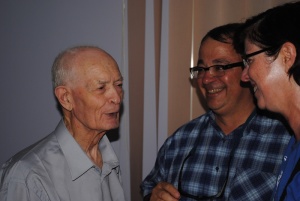 cemetery, the quietude of the shattered city – sent a shock through my body and my soul. Here, in an antiseptic retirement home in a made up, rebuilt city in the shadow of a pile of rubble of a village where people have been the leading export for generations it was clear that that connection, a simple human connection, the touch of a hand and a peck on a cheek between a nonagenarian and his American relative – between paesan – between family – is what enables us all to carry on and what sustains us.
cemetery, the quietude of the shattered city – sent a shock through my body and my soul. Here, in an antiseptic retirement home in a made up, rebuilt city in the shadow of a pile of rubble of a village where people have been the leading export for generations it was clear that that connection, a simple human connection, the touch of a hand and a peck on a cheek between a nonagenarian and his American relative – between paesan – between family – is what enables us all to carry on and what sustains us.
 It was a privilege to be able to observe this.
It was a privilege to be able to observe this.
Ci vediamo!
Bill and Suzy

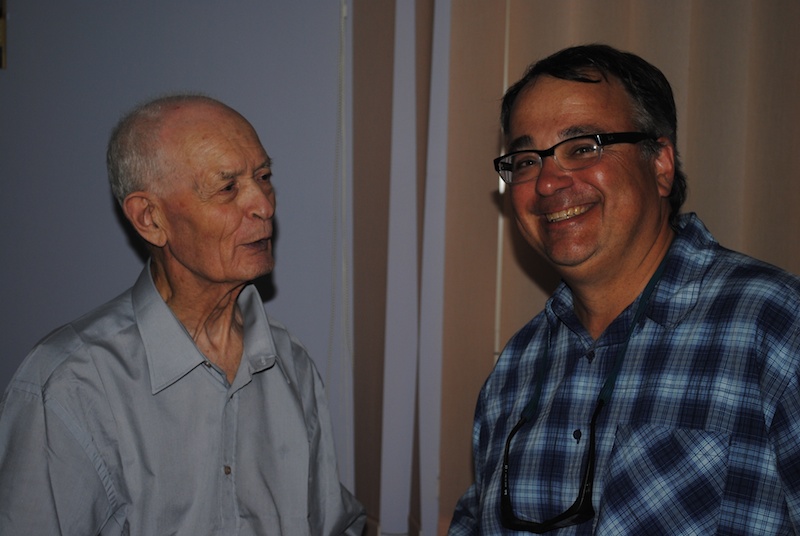
Bill and Susi:
Thank you so much your notes and pictures—they are wonderful. I’ll always remember Salaparuta as it was in 1953 when I took my mother and father there. His first and only visit since he left as a 5 year old on a mule drawn wagon with his mother and siblings to go to Palermo to board the boat for New Orleans . I have some slides which might include shots of some of the family members whose graves you visited.
Love,
Ned
Bill,
Just a note of thanks from or Pete’s first cousin in Georgia for a wonderful post. Oddly enough, my new wife (Jane) and I were in New Orleans on the same day, apparently, that you were in the cemetery in Salaparuta…..and “doubly oddly enough”, we visited the mausoleum crypts there (in Matarie, La) where our grandparents (Dr. Peter and Rosine) grandparents were buried. It was a wonderful re-connection for me, and reading your account has made it just that much more special….Thanks!
Tom Graffagnino.
I have returned to re-read your blog post several times since Peter emailed me of its existence and have yet failed to be moved by it. My wife, Sarah, and I were able to visit Salaparuta and to meet with Father Baldassare in the Fall of 2000 and have vivid memories of that visit. We had been in contact with Father G prior to our visit, so he was expecting us. From the moment we arrived until the time we left, he was an uninterrupted torrent of information and questions. Unfortunately his assistant at the time – a local school teacher – was unavailable, making my extremely limited Italian the only means of communication! Father G showed us around his offica/apartment, then packed us into our rented car car and directed us on a tour of the neighborhood, which included a walk through of the ruins of both Poggioreale and Salaparuta. Some marble(?) flooring and a couple of walls of his former church were still standing at the time atop the hill that once presided over the town. There was sadness in his eyes then, more than thirty years after the earthquake.
I have not heard from Father G since that time, and I am so pleased and grateful that you and Peter were able to make that connection and find him well.
My mother was born in old Salaparuta and came to the States in 1937. We still have family there although they have relocated to the new town. We had a great reunion with them in 2006 and I really felt like I had come home. My cousin Frank found your blog any shared it with us. it was wonderful to read. Thank you.
Thanks for your kind words, Rosalyn. Being able to visit Salaparuta with my dear friend and witness and experience his emotions in his homecomings is one of my cherished Italian memories. I’m glad you were able to experience it too.
Best regards,
Bill